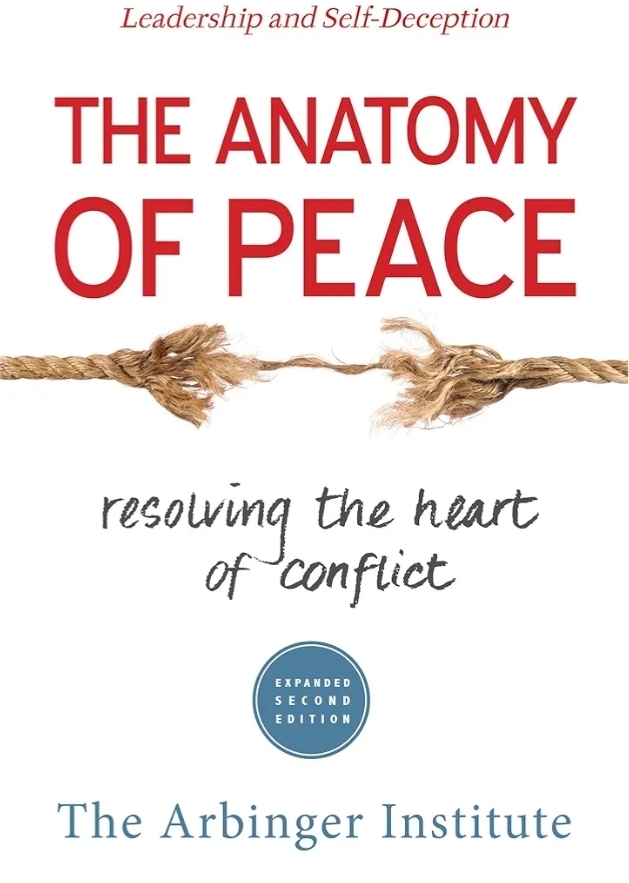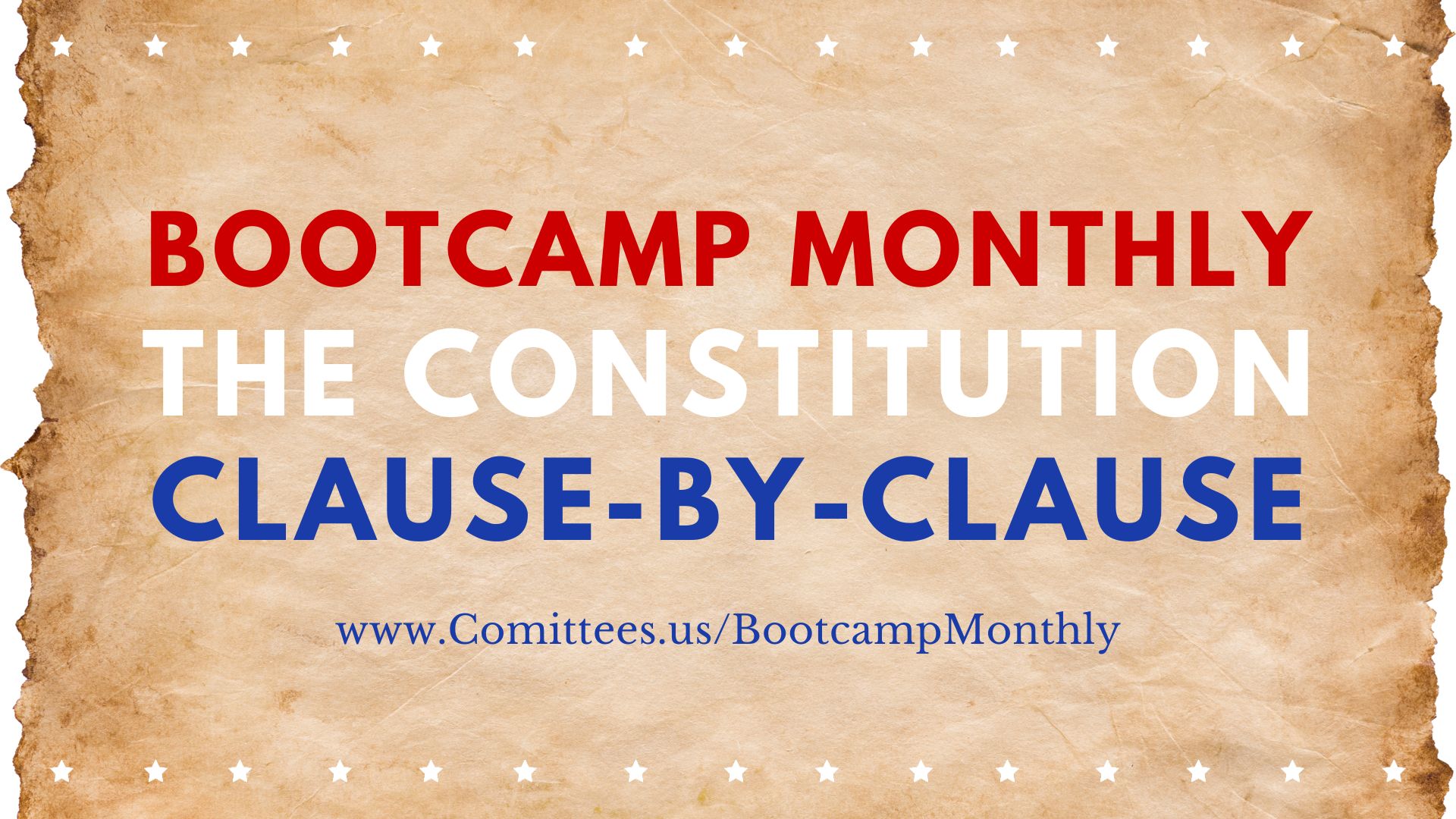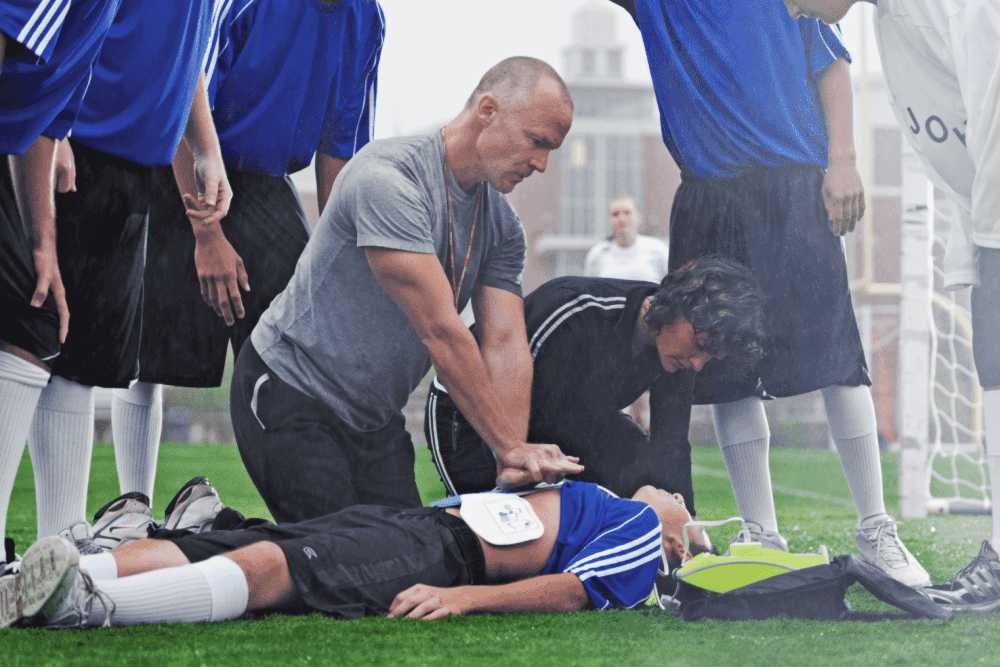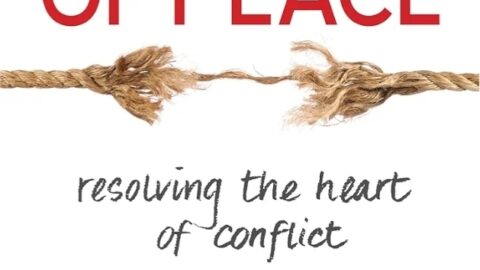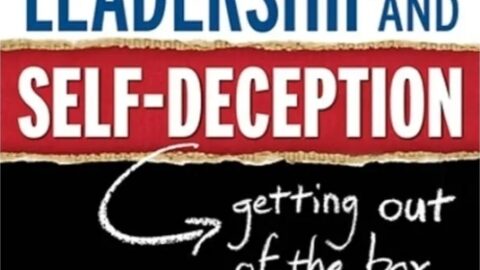Core question: What kind of heart am I bringing to this conflict—one that sees people as persons to be cared for, or as objects to be used, resisted, or ignored?
Tagline (spirit): “Wars of the world persist because we carry wars in our hearts.”
Conflict persists not mainly from disagreement but from a Heart at War—a stance born of self-betrayal that justifies itself by dehumanizing others. Peace begins when I adopt a Heart at Peace—seeing others as people with hopes, fears, and burdens, then acting for their good. Techniques without a heart-change backfire; policies without personhood entrench cycles of blame and control.
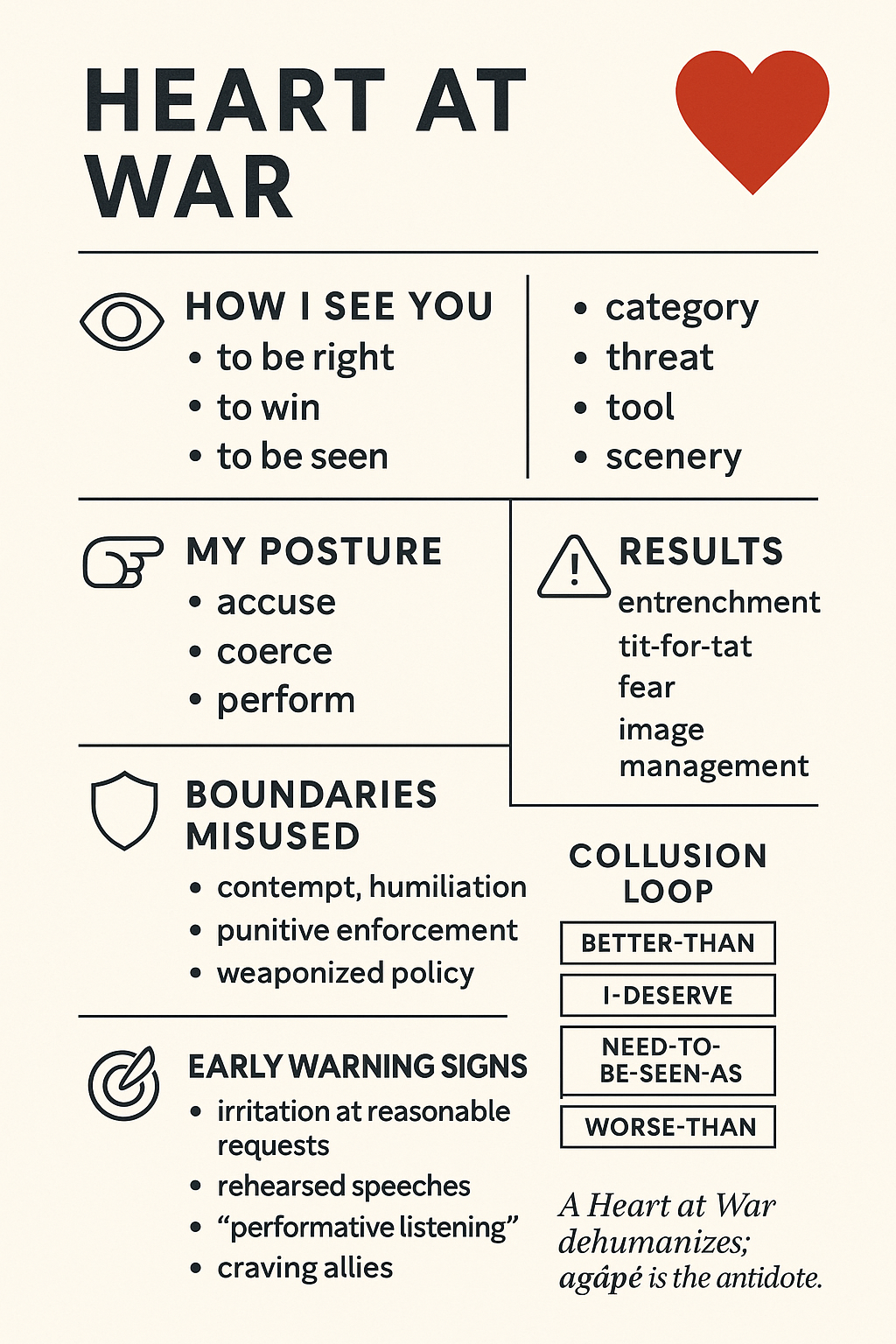
The moral engine of the book
- Self-betrayal → justification → collusion: I feel a moral nudge to do good; I don’t; I justify; I now need others to be the problem so my story holds. My stance invites their defensiveness (collusion), which “proves” my story.
- Two hearts, two worlds:
- Heart at Peace: I honor others as persons; I’m responsible for my stance; I seek truth over vindication; I’m open to being corrected.
- Heart at War: I see objects (obstacles/vehicles/irrelevancies); I need blame; I curate evidence; I pressure and pose.
Kohlberg lens: Heart at War locks us in Stage 2/3 (reward/approval games). Heart at Peace moves toward Stage 5/6 (principled conscience—agápē).
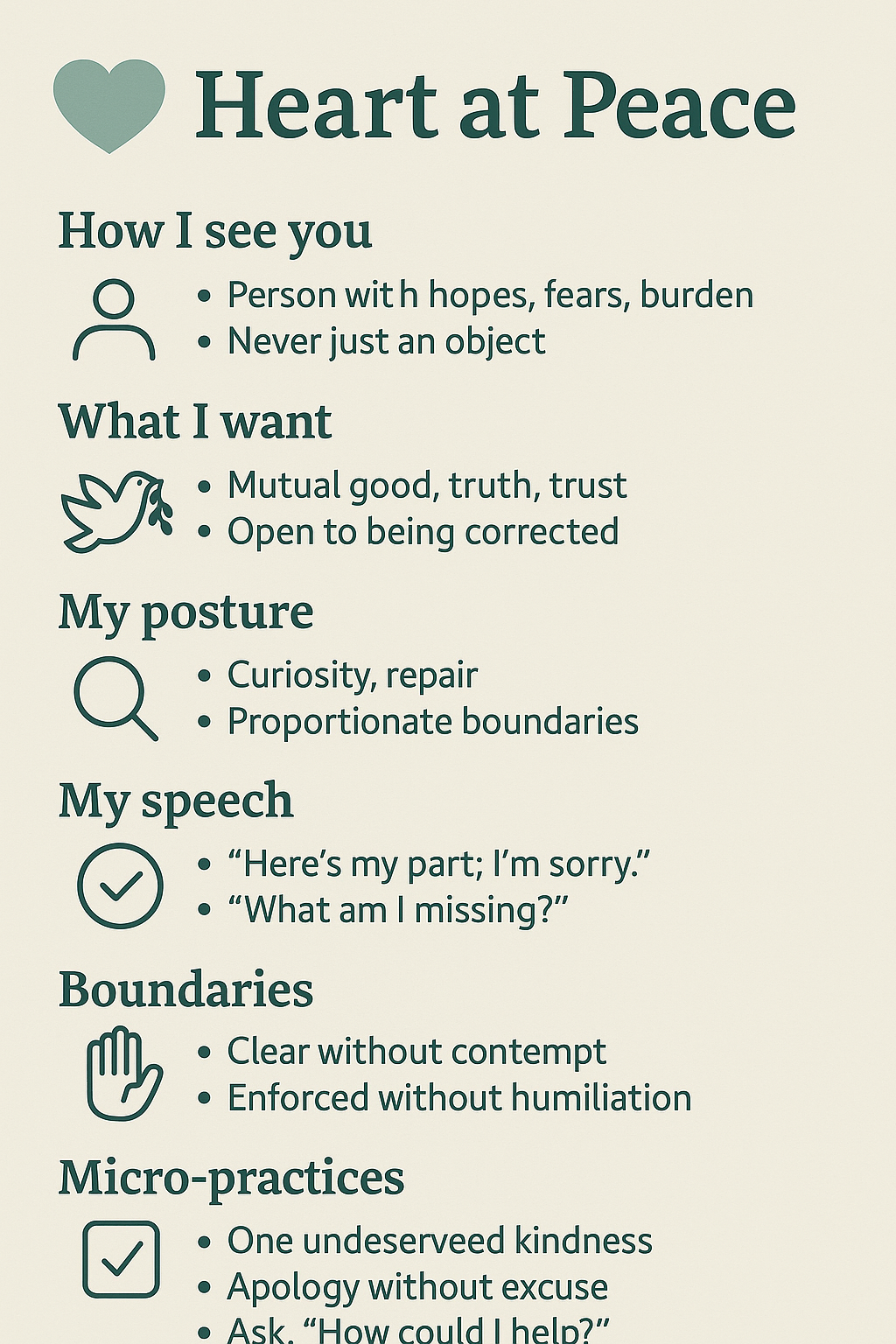
Heart at Peace vs Heart at War (fast contrast)
How I see
- Peace: Persons with needs, histories, limits, glory.
- War: Stereotypes, threats, tools, scenery.
What I want
- Peace: Mutual good, reality-based solutions, durable trust.
- War: To be right, to win, to be seen as righteous.
What I notice
- Peace: My contribution to the problem; their constraints.
- War: Their offenses; my justifications.
How I act
- Peace: Curiosity, repair, proportionate boundaries.
- War: Accusation, coercion, performative “listening,” punishment loops.
What it produces
- Peace: Safety, candor, joint problem solving.
- War: Image management, fear, entrenchment, tit-for-tat escalation.
Three great misdiagnoses (why conflicts stay stuck)
- Technique over stance: We seek scripts, incentives, or comms plans while keeping a Heart at War. People feel used; resistance hardens.
- Blame over responsibility: “If they’d change, we’d be fine.” Even when others err, my stance still multiplies or mitigates harm.
- Outcomes over persons: Chasing KPIs (Key Performance Indicators) without honoring people breeds the very failures we measure (turnover, churn, cynicism).
The four common “war styles” (how war shows up)
Not personalities—postures we adopt to stabilize our justification.
- Superior (Better-Than): I moralize and lecture; others feel small and rebel or collapse.
- Entitled (I-Deserve): Scorekeeping and resentment; others defend and withhold.
- Performative (Need-to-Be-Seen-As): Optics over honesty; others stop trusting the stage.
- Deflated (Worse-Than): Helplessness that offloads responsibility; others over-control, confirming my story.
These styles collude with one another, making everyone feel “right” while outcomes degrade.
Early warning signs I’m in Heart at War
- Irritation at reasonable requests; eagerness to recount others’ flaws.
- “Always/never” language; rehearsed courtroom speeches.
- Doing “nice” things to manipulate optics.
- Craving allies more than truth; punishing candor; rewarding flattery.
- Fatigue from image maintenance; numbness toward specific people.
Shifting to Heart at Peace (personal practice)
Peace begins with how I see, not with whether they deserve it.
- Name the betrayal: Where did I feel to do a small good and didn’t? (Return the call, admit delay, give credit.)
- Humanize the other: List their pressures, fears, and hopes. What burden might they be carrying today?
- Own impact (no but): “My late handoff put you in a bind. I’m sorry.” Stop at the period.
- Give one unjustified help: A concrete, costly assist my story says they don’t deserve. Act before arguing.
- Invite correction: “What am I missing? What would help most?” Receive, don’t rebut.
- Hold firm boundaries humanely: Peace ≠ permissiveness. Say no without contempt; enforce standards without humiliation.
Leading systems from Peace
- Make people safe to be persons: Protect dissent; reward truth over optics; separate performance review from retaliation.
- Design for personhood: Fewer performative meetings; more joint problem-solving at the point of pain (customer, patient, student).
- Pair KPIs with KPEs (Key People Effects): Track burden hours removed, rework avoided, trust markers (escalations down, candor up).
- Map collusion loops: Where do Superior ↔ Deflated or Entitled ↔ Performative feed each other? Intervene at interfaces, not just individuals.
- Hire/promote for stance: Curiosity + repair history > résumé polish.
Family & culture bridges
- Covenant over contract: Heart at Peace restores fidelity, truthful repair, and shared purpose; Heart at War reduces relationships to transactions (perform for benefits).
- Generational creeps: Cultural/education/religious creep accelerates when institutions optimize optics (Performative war) and citizens nurse entitlement (I-Deserve), while “Superiors” moralize and “Deflated” withdraw.
- Agápē lens: Peace is not softness; it is willing the good of the other at cost to self, joined to truthful boundaries.
- Misdiagnosis principle: Treating a stance problem with policy fixes alone deepens decay.
Quick diagnostics (use anytime)
- What story must be true for my anger to stay justified?
- What fresh evidence would force me to revise my view of them?
- If I were wrong here, how would I know? Who could tell me?
- What small undeserved good can I do before day’s end? (Do it.)
One-page practices (keepable)
- Daily: Write three names; for each, one humanizing fact and one undeserved help.
- Weekly: Apology without defense + ask, “What would better look like for you next week?”
- Monthly team: Tell one “I caught my self-betrayal early” story; celebrate another’s people-honoring decision.
- Quarterly: Collusion map across functions; redesign one interface for joint problem-solving.
Bottom line
A Heart at War makes enemies even out of those we love and serve, and turns every tool into a weapon of self-justification. A Heart at Peace begins with seeing—persons, not props—then acting for their good with truthful boundaries. Techniques follow stance; outcomes follow sight. Peace scales when leaders go first.
What is Agápē?
In classical Greek, “love” has several hues:
- Agápē — sacrificial, unconditional love that wills the good of the other, even at personal cost.
- Érōs — romantic/erotic desire; attraction and longing.
- Philia — friendship/affection; camaraderie through shared virtue and purpose.
- Storgē — familial love; natural affection within family bonds.
Why Agápē fits The Anatomy of Peace
Heart at Peace vs. Heart at War
- A Heart at Peace sees people as persons—with hopes, fears, limits, and glory—and acts for their good.
- A Heart at War sees people as objects—obstacles, vehicles, or irrelevancies—and seeks vindication.
Agápē is the stance that sustains a Heart at Peace: it chooses the other’s good over the maintenance of my self-justifying story.
Agápē heals the self-betrayal loop
- Self-betrayal: I sense a nudge to do good and refuse, then justify.
- War-heart consequence: I now need you to be “the problem” to uphold my story.
- Agápē move: Do the good anyway—before it’s deserved or noticed. Action breaks the justification and rehumanizes the other.
Agápē reframes conflict aims
- From winning to belonging: Not “How do I beat you?” but “How do we do right by the good we share?”
- From optics to reality: Not “How do I look reasonable?” but “What truly helps you—even if no one sees?”
Agápē with boundaries (peace ≠ permissiveness)
- Say no without contempt; enforce standards without humiliation.
- Pair truth with care: “Here’s the standard; here’s my help to reach it.”
Quick contrast: Agápē in practice
| Dimension | Heart at War (no agápē) | Heart at Peace (agápē) |
|---|---|---|
| How I see you | Category, threat, tool, scenery | Person, image of God, bearer of burdens |
| What I want | To be right / to win / to be seen | Mutual good, truth, durable trust |
| My posture | Accuse, coerce, perform | Curiosity, repair, proportionate boundary |
| My speech | “You always/never…”, courtroom scripts | “Here’s my part. I’m sorry. What would help most?” |
| Result | Entrenchment, tit-for-tat escalation | Safety, candor, joint problem-solving |
Agápē micro-practices (drop-in, do-today)
- Unjustified good: Offer one concrete help your story says they “don’t deserve.”
- Impact over intent: “My delay put you in a bind. I’m sorry.” (Stop at the period.)
- Humanize on paper: List three plausible burdens they’re carrying.
- Invite correction: “What am I missing? What would better look like for you?”
- Boundary with benevolence: Clear expectation + a way you’ll support meeting it.
One-liners to weave into the chapter
- “Agápē turns opponents into neighbors and problems into shared projects.”
- “A Heart at War needs a villain; agápē needs a person.”
- “Peace begins where justification ends—and agápē ends justification.”
- “Agápē doesn’t soften truth; it softens hearts so truth can work.”
Bottom line
The Anatomy of Peace is about stance before strategy. A Heart at Peace is sustained by agápē—choosing the other’s good over the survival of my story. From that stance, techniques help; without it, even good techniques become weapons.

